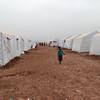clear
The biggest refugee camps are in Kenya. Why?
clear
Some of the biggest refugee camps in the world, such as Dadaab, were originally setup to accommodate those fleeing the Somali civil war; as Kenya is the closest country to Somalia, it's only natural that refugees would flee there, especially as the border is large with little control. And once a settlement is in place, it quickly populates, especially when other conflict occurs. Kenya is also at the centre of an array of conflicts and, therefore, accommodates refugees from all surrounding countries, including Ethiopian refugees that fled after the fall of the Ethiopian government. The camps in Kenya may not be the most well equipped, but they offer refugees a haven close enough to home that they don't have to travel across continents to reach safety, like in the recent Syrian conflict and consequent refugee crisis. During or after conflict, it is only natural that you would travel to the nearest point of safety and, if that offers you somewhere to sleep and eat and gives you little reason to travel back to the country you came from, presuming that’s ever possible, there’s little reason to leave. In turn, this drives up camp population to staggering numbers.
 0
0
clear
The biggest refugee camps in Kenya are Dadaab, Kakuma, Hagadera, Dagahaley, and Ifo. The Dabaab camp hosts about 250,000 refugees and is the most popular of the five largest camps. The Hagadera camp is part of the Dabaab camp and hosts about 105,998 refugees primarily from Somalia. The Dagahaley camp is also a part of the Dadaab camp and hosts nearly 87,223 refugees who fled from the Somali Civil War in the 1990's. The Ifo camp is the oldest of the Dadaab camp complex and hosts about 84,089 refugees, also mainly from Somalia. The Kakuma camp, established in 1992 hosts about 184,550 and is in Northwestern Kenya. The reason for these refugee camps are drought, famine, violence, and civil war in Somalia, South Sudan, and Ethiopia. These camps are overcrowded, massively congested, little opportunity for employment, and are often dealing with high cases of malnutrition and disease. All leading to a constant threat from the Kenya government to shut them down again displacing hundreds of thousands of refugees. It is important to note that a high number of Somalia refugees are resettled to the United States, Canada, and Australia, as well as, Norway, Sweden, and the UK, in Europe.
 0
0
clear
 Kristen Morris
7 years, 5 months ago
Kristen Morris
7 years, 5 months ago
Kenya is a relatively peaceful nation unlike most countries in Africa. The only notable clashes that have happened in their history are ethnic clashes in 1992 and post-election violence in early 2008. Both conflicts were resolved with the help of the international community. In comparison, most countries that neighbor Kenya have long-running conflicts and disputes since the independence wave witnessed in Africa in the 1960's. Ethiopia, Somalia, Uganda, Sudan, and recently South Sudan all have millions of refugees who went to Kenya for refuge. Currently, Uganda, South Sudan and Somalia contribute the most refugees in Kenya. Also, Kenya is widely known as a democratic country, and it has ties with most nations. As a result of this political stability, the economy of the country is well off compared to those of her neighbors. This very attractive to not only refugees but also those that look to seek for greener pastures. The Kenyan government has reportedly threatened to close these refugee camps because they act as a haven for smugglers and the black market. Those threats are yet to come to fruition.
 0
0
clear
 Alvine Spencer
6 years, 10 months ago
Alvine Spencer
6 years, 10 months ago

Sign up to post or vote on answers.
Improveo will help systemize your knowledge.